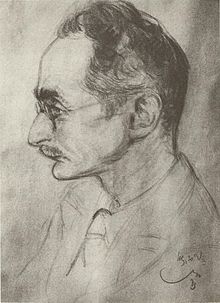You can help expand this article with text translated from the corresponding article in German. (May 2023) Click for important translation instructions.
|

Paul Maas (18 November 1880, in Frankfurt am Main – 15 July 1964, in Oxford) was a German scholar who, among other things, developed principles of textual criticism inherited from Karl Lachmann.
He studied classical philology at the universities of Berlin and Munich, receiving his doctorate in 1903. In 1910 he obtained his habilitation and in 1920 became a full professor at Berlin. In 1930 he was appointed chair of classical philology at the University of Königsberg. In 1934 he was forced into retirement by the Nazi government due to his Jewish ancestry, and in 1939 he emigrated to Great Britain, where he taught classes at Oxford University. After his death, he was buried at Wolvercote Cemetery's Jewish section in Oxford.
Research activity
His research interests lied mainly in textual criticism of Greek literature, poetry in particular.
Unlike most of his colleagues, he produced a relatively small number of critical editions: of a collection of Byzantine liturgical poetry (1910); of Apollonius Dyscolus' treatise "On pronouns" (1911); and of Romanos the Melodist's poetry, with Greek scholar C. A. Trypanis (1963, 1970).
He also wrote extensively on Nonnus of Panopolis, although most of his conjectures and observations he never published and only wrote on the margins of the editions by Arthur Ludwich and Rudolf Keydell he owned. A similar work he carried on Apollonius of Rhodes, on Athenaeus and on Herodotus. Classical scholar Willy Theiler once observed that Maas's printed contributions to classical philology must be multiplied by ten, because most of Maas's reflections and thoughts were not published by him and still are not.
His most famous work is the "Textkritik" (1927), a concise theoretical handbook of textual criticism. It has been translated into many languages. He also wrote a handbook of "Greek metre" (1923) and the handwritten notes for his unpublished "Byzantinische Metrik" have recently been discovered at Copenhagen.
His articles were collected by Wolfgang Buchwald in 1973.
Maas's law
Maas formulated Maas's law, an observation of the layout of bookrolls.
Works by Maas published in English
- Textual criticism (1958), translation of Textkritik, 1927.
- Greek metre (1962), translation of Griechische Metrik, 1923.
Literature
- Katja Bär: Paul Maas. In: Robert B. Todd (Hrsg.): Dictionary of British Classicists Vol. 2. Bristol 2004.
- Charles Oscar Brink: Paul Maas (1880–1964). In: Eikasmós 4, 1993, S. 253–254. (Abstract)
- Richard Kannicht: Griechische Metrik. In: Heinz-Günther Nesselrath (Hrsg.): Einleitung in die griechische Philologie. B. G. Teubner, Stuttgart/Leipzig 1997, ISBN 3-519-07435-4, S. 343–362.
- Hugh Lloyd-Jones: Paul Maas †. In: Gnomon 37, 1965, S. 219–221.
- Hugh Lloyd-Jones: Paul Maas (1880–1964). In: Eikasmós 4, 1993, S. 255–262. (Abstract)
- Eckart Mensching: Über einen verfolgten deutschen Altphilologen: Paul Maas 1880–1964. Berlin 1987.
- Peter Wirth (1987), "Maas, Paul", Neue Deutsche Biographie (in German), vol. 15, Berlin: Duncker & Humblot, pp. 597–597; (full text online)
References
- "Paul Maas - stemmatology". wiki.uib.no. Archived from the original on 2014-04-13.
- "Textual Scholarship: Stemmatics".
- Kraatz - Menges / edited by Rudolf Vierhaus Deutsche Biographische Enzyklopaedie
- ^ Maas, Paul In: Neue Deutsche Biographie (NDB). Band 15, Duncker & Humblot, Berlin 1987, ISBN 3-428-00196-6, S. 597.
- Castelli, Carla (2023). "Sondaggi maasiani: postille e carteggi inediti sulle Dionisiache di Nonno tra le edizioni Ludwich e Keydell" (PDF). Commentaria Classica. 10: 255–272.
- Pace, Nicola (2005). "Le postille di Paul Maas ad Apollonio Rodio". In Pretagostini, Roberto; Dettori, Emanuele (eds.). La cultura ellenistica. L'opera letteraria e l'esegesi antica. Atti del Convegno COFIN 2001, Università di Roma "Tor Vergata", 22-24 settembre 2003. Rome: Edizioni Quasar. pp. 437–450.
- Fowler, Robert (2010). "Paul Maas's Athenaeus". Zeitschrift für Papyrologie und Epigraphik. 172: 55–64. JSTOR 20756785 – via JSTOR.
- Wilson, Nigel Guy (2011). "Maasiana on Herodotus". Zeitschrift für Papyrologie und Epigraphik. 179: 57–70. JSTOR 41616875 – via JSTOR.
- Theiler, Willy (1950). "A Select List of Writings of Paul Maas (1901-1950) (review)". Gnomon. 26 (2): 140–141. JSTOR 27680885 – via JSTOR.
- E.g. Maas, Paul (1972) . Critica del testo. Translated by Martinelli, Nello. Con una presentazione di Giorgio Pasquali, lo Sguardo retrospettivo 1956 e una nota di Luciano Canfora (3 ed.). Firenze: Le Monnier. See also: Montanari, Elio (2003). La critica del testo secondo Paul Maas: testo e commento. Firenze: SISMEL—Edizioni del Galluzzo. Maas, Paul (2017). La critica del testo. Translated by Ziffer, Giorgio. Roma: Edizioni di Storia e Letteratura.
- Maas, Paul (1973). Buchwald, Wolfgang (ed.). Kleine Schriften. München: Beck'sche Buchandlung.
- Textual criticism OCLC WorldCat
- 1880 births
- 1964 deaths
- German classical scholars
- Jewish emigrants from Nazi Germany to the United Kingdom
- Academic staff of the University of Königsberg
- Academic staff of the Humboldt University of Berlin
- Textual criticism
- Members of the German Academy of Sciences at Berlin
- Corresponding fellows of the British Academy
- Burials at Wolvercote Cemetery